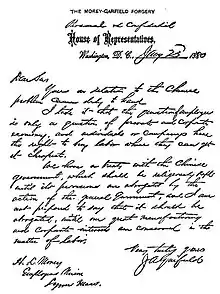Morey letter
The Morey letter was a letter that appeared during the 1880 United States presidential election. It was purportedly from James A. Garfield, the Republican presidential candidate, and suggested that Garfield was in favor of Chinese immigration. It was subsequently declared a forgery.[1]

Scandal
The letter was written on House of Representative official stationery dated January 23, 1880 and addressed to Henry Lee Morey of the Employers Union in Lynn, Massachusetts. The letter stated, “individuals and companies have the right to buy labor where they can get it cheapest”, And it goes on to touch upon how the treaty with china should stay in effect until the end of Americas manufacturing needs are fulfilled from the cheap labor.[2]
On October 21, New York newspaper The Truth featured the letter with a quote from a reporter saying that a friend of Garfield’s had confirmed that the handwriting was indeed Garfield’s.
Reaction
Democratic attacks
Democrats used this letter to their advantage and started to print and circulate the letter wherever they could. They were able to get over 500,000 copies out. They put the letter in store windows and sent it to areas with a great number of Chinese immigrants, to maximize controversy. The letter was an October surprise that the Democrats thought would flip the vote to their favor. They even called the letter “Garfield’s death warrant.”[3]
Garfield's response
Garfield received a telegraph on October 20, 1880, regarding about a letter the candidate had allegedly written regarding "the Chinese question," that is, the question of the railroad companies hiring and importing Chinese labor to complete projects. Later that same day, he received the text of the letter.
Garfield requested a photo reproduction of the letter, and once he laid eyes upon it, he denied that he wrote the letter. He stated that it was a “manifestly bungling attempt to copy [his] hand and signature”.
During this time, Republicans also sent an investigator to Lynn, Massachusetts to try to find any trace of the letter. The investigator could not find H. L. Morey or the Employers Union. Shortly after, Garfield wrote and told the Republican National Committee to reproduce a letter of him denying that the letter was his.
Garfield’s real letter did not get published by any newspaper for about a week, and was often printed side by side with the original Morey letter.
Result
Democrats said that the delay was evidence of Garfield’s guilt. Most voters eventually thought the letter was a forgery, and just another political trick to win votes. The Morey letter was thought to be a forgery emanating from Democratic Party operatives, and produced a backlash against the Democrats.
While never proven, there was much public speculation at the time that Stanley Huntley, journalist at the Brooklyn Eagle and creator of the Spoopendyke humor stories, was the author of the Morey letter. Huntley himself had made fun of the question of who wrote the letter in one of his stories.
References
- Gyory, Andrew (October 24, 2004). "The Phony Document that Almost Cost a President His Election". History News Network. Retrieved 7 December 2011.
- "Garfield's death warrant. That letter in which he advocates an extended Chinese immigration --- He advises that employer's union of Lynn, Mass., "that the question of employees is only a question of private and corporate economy" ---Read, Workin". Library of Congress, Washington, D.C. 20540 USA. Retrieved 2019-05-07.
- "Garfield's death warrant. That letter in which he advocates an extended Chinese immigration --- He advises that employer's union of Lynn, Mass., "that the question of employees is only a question of private and corporate economy" ---Read, Workin". Library of Congress, Washington, D.C. 20540 USA. Retrieved 2019-05-07.
External links
- A facsimile of the Morey letter in the Advertiser Extra (which attributes it to Garfield).